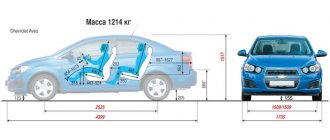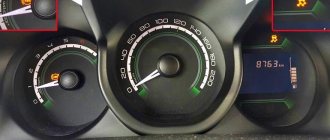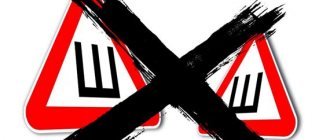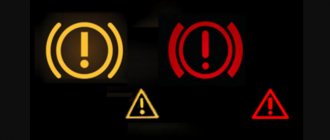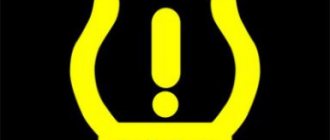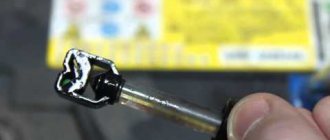Everyone on the road often encounters a white sign with a red border on a white background. But what does it mean? Let's try to give an explanation.
The designation in the collection “Road Signs” is sign 3.2 Traffic is prohibited. Where a similar road sign is placed, a white circle with a red border, traffic is prohibited. Here are the main reasons for this;
- Forbidden territory.
- Parking lots intended for official vehicles or transport of building residents.
- Traffic control in courtyards, schools, kindergartens, etc.
- Road repair.
- Carrying out various events.
In practice, this means that if you enter the territories marked with sign 3.2 without having a valid reason, at best you can receive a warning.
As a rule, driving on both sides of the road is prohibited; The main difference from the well-known “brick”, which can be installed anywhere, and the road sign is a white circle with a red border - only on a two-way traffic area.
The road sign, a white circle with a red border, does not have a strict covering - the end of the action is considered to be the installation of the corresponding duplicate sign with a mark indicating the end of the action, or the first intersection. Less often - the end of the road with an adjacent sign.
Such a sign may be supplemented with additional signs;
1. Sign 8.3.1-3 with arrow indications of the further direction of action.
2. Sign 8.5.1-4, indicating the duration of the installed road sign 3.2.
Used when carrying out events, repair work and other things on the covered section of the road.
What does a white circle with a red border mean?
Before the intersection, in accordance with the traffic rules, prohibiting symbols have designations certifying the purpose of the impact.
The most diverse signal and the 2nd most important prohibition for drivers and traffic police inspectors is “Traffic is prohibited.” Domestic and foreign car owners and legal advisers believe that there are a very large number of signs and exceptions for such a sign.
In educational institutions (driving schools), the meaning and meaning of the symbol is explained in detail - “Entry is prohibited” (“brick”) and “Traffic is prohibited.” The first one prohibits anyone from entering a specific part of the road from the designated area (including disabled people and residents of houses behind a prohibitory sign). The second restricts the passage of vehicles and the movement of pedestrians. Entrance to this section of the road is absolutely free for all categories of citizens.
The road signal “No movement” introduces a categorical prohibition on the movement of vehicles in a specific area. At a theoretical level, this signal does not contain territorial restrictions. The beginning of the prohibition is the space where the signal is installed.
If the prohibition applies to side exits, this is classified by special signs that prohibit movement in the direction indicated by arrows. Because this signal, in accordance with the traffic rules, limits movement in both movement instructions, it is not specified at intersections that have a slope to a one-way street.
Depending on the purpose, it is possible to enter a prohibiting signal:
- Almost on any part of the road or intersection, street, boulevard, driveway, to define a zone for pedestrians.
- On the road and highways where cars drive or on the street for the purpose of temporarily blocking the movement of vehicles (this can be a mass event).
- On roads, city highways, to block traffic in the area where repair work is taking place on the site.
- Before entering a traffic lane that ends in a dead end, or into a yard with one entrance for the purpose of warning (it is installed together with a sign indicating a dead end).
- To the checkpoint and/or entry to the official territory of organizations or enterprises.
The visual signal “No movement”, in accordance with traffic rules, must be indicated by a table with black arrows. They show the specific purpose for which the signal functions, or signs that indicate the types of direction and/or crossing time. In cases where it is necessary to pass under this symbol, but this is impossible to do, then you must go to the end of the restricted zone.
Obstacles may be a post office, a retail store, or an educational institution. If the vehicle is stopped by traffic police inspectors, you must tell the authorized persons about the purpose of the trip. In traffic rules, road movement is the authorized movement of vehicles on specially equipped roads.
The second condition for movement is the crossing of 2 or more intersections. At a theoretical level, a prohibiting signal involves prohibiting transit movement from the first intersection to the next. This means that driving and stopping on this section of the road is not considered a violation.
The number and types of road symbols, taking into account the territorial location of the road, is the responsibility of the division of the road organization serving this section of the roadway. All signs must strictly comply with the installation scheme of road symbols and a specific type in order to avoid trouble. Such road signs are especially important for young and inexperienced drivers.
According to traffic rules
In the rules, the sign with a red ring is designated by the numbers 3.2 and belongs to the category of prohibitory signs. It means that movement by vehicles is strictly prohibited on the further section of the road. Moreover, the ban applies in both directions.
Coverage area A pillar with a white background, surrounded by a red circle, has its own coverage areas:
- at the entrances to the prohibited territory;
- in places where repair work is carried out;
- in front of pedestrian traffic areas; in front of adjacent areas where there is a dead end.
Dimensions and markings according to GOST
To create a road sign, technical specifications are taken from GOST. According to the rules, it goes under number 3.2 in the list of designations. According to the requirements, size 1 with a diameter of 600 millimeters is used. This is a circle with a red border, which also has its own size - 0.1 diameter. The interior is lined in white.
At the bottom there are often small black tables indicating the restricted area and movement arrows.
According to legal standards, the colors used for road signs must be clearly visible in the light and dark, bright and saturated (not “poisonous”). The materials used in manufacturing must be durable and impact-resistant. Similar colors and sizes are necessary for the “visibility” of the object by the driver and pedestrian (traffic participants).
Perhaps, from 2022, other designations will be used, in which additional information is placed at the bottom of the road sign itself. Many experts are against innovation due to the low visibility of the object.
Coverage area
The coverage area is beyond the established boundaries of populated areas - villages, towns, villages, urban settlements. Thus, warning symbols are specified on the roadway in such a way that all road users have the opportunity to see and distinguish them at a distance of 150-300 meters under normal weather conditions during the day and night for the safe crossing of road sections.
The presence of trees, bushes, houses and communications are also taken into account (obstacles), since nothing can obstruct the visibility of legal information. The location of the transport road according to road symbols in populated areas is in most cases identical, and just at a distance of 50-100 meters from the unsafe section of the road.
There are special services that take into account the speed of vehicles moving along the suburban route, which is higher than in populated areas. The overall rules clearly stipulate that marketing billboards and various banners should be positioned so as not to obscure the symbols located on the right side of the roadway.
This is designed for the convenience of everyone, making it easier to spot them on the road. If necessary, the location on the right side is subject to duplication with their location on the opposite, left side of the roadway.
It is also recommended to place the symbols approximately at the same level from the control line in order to simplify their perception. As a rule, the road symbol apparatus is installed on the ground, and the terrain of the territory, the stress of movement and the presence of other unsafe elements are taken into account, especially if this concerns some restrictions. The number of characters is regulated by appropriate instructions.
On the segment of roadway movement inspected by authorized persons, it is possible to place no more than 3 symbols, but this figure is taken without taking into account duplicated and other symbols. The main task of authorized persons is to introduce or remove the basis for the appearance of an obstacle or duplication.
Exceptions
The “No Traffic” sign has exceptions - “more equal than others” in this case will be:
- Russian Post cars with a characteristic identification mark (diagonal white stripe on a blue background);
- route transport;
- cars transporting disabled people ( groups 1 and 2 , no matter in what capacity - driver or passenger);
- cars of citizens permanently residing in this zone or servicing enterprises located in it.
Of course, have documents with you proving that this ban does not apply to you .
For example, invoices, certificates, passport with registration. As for disabled people, we are talking not only about documents confirming their status - that goes without saying.
itself must be equipped with appropriate signs indicating that people with disabilities are driving it.
Keep in mind that the “road guard” will most likely stop the person driving under the limiter. After which he will ask for documents and if they are not available, then a fine will be issued for driving under the “no traffic” sign.
Fine
What is the fine for driving under a “No Traffic” sign? Not that big, only 1,500 rubles ( Article 12.16 of the Code of Administrative Offenses of the Russian Federation ). Why so few? The authorities believe that despite the violation of the “no movement” sign, this act in itself is not dangerous and the driver does not create an emergency situation. After all, no other cars are expected to be in this zone. But neglecting the “brick” threatens with deprivation of rights.
Here you will find information about other fines for traffic violations.
What punishment is provided by law?
Quite often, drivers do not pay attention to this sign and break the rules when entering. It should be noted that such a violation entails administrative liability in the form of a fine. In 2022, the penalty for driving under this sign is only 500 rubles. And sometimes the inspector even issues a verbal warning to the driver.
In this case, the degree of severity will depend on the arguments of the offender. If a violator is stopped more than once for driving under a prohibitory sign, then he will have to fork out and pay the amount written out by the inspector as a punishment.
How traffic police officers prove a violation
In most cases, violations are recorded personally by traffic police inspectors. Near the “No Traffic” zone, which has a red edge, there is often a patrol station that stops drivers who have violated traffic rules. If the driver of the car has documents with him that give priority and permission to travel, then he is calmly released to continue driving. If the driver does not have the right to drive under the sign, then he is issued a protocol.
If the driver believes that the protocol was issued in violation of the laws, then he can try to challenge the decision to fine the traffic police. But in practice this is almost impossible to do. But if the driver has the necessary documents for travel, but is still given a fine, then it’s worth fighting for your rights. For example, if, having stopped a forwarder of a retail outlet who has documents, he was still given a fine.
In any case, the first thing you need to remember is that you should not be rude to a government official. But you shouldn’t give your driver’s license to the inspector. The driver also has every right to take photos or videos of everything that happens. The police officers are on duty at this moment, so the ban on filming private life does not in any way apply to such situations.
In the protocol, do not rush to sign everything that the inspectors indicated. Please read the document carefully. If you don't agree, write it there. In general, if you are faced with unlawful actions, try to do everything so that later you have a solid evidence base that will be taken into account in court.
How can traffic police officers prove this offense?
Usually they don’t have to prove anything - a traffic police patrol is located nearby, which records the offense. After which the car, which risked not noticing the eloquent sign, is stopped in order to find out what the reason is. Or the fact of illegal entry was “caught” by a video camera.
As for challenging it , it is practically impossible . It's better to tune in to this right away. Unless you have a document proving that you had the right to go .
Or the camera does not recognize that the car is yours (for example, unreadable license plates). It's a different matter if you are faced with arbitrariness .
For example, you are a forwarder for a store that is located right in the disputed territory, you have papers with you confirming the fact of your work - but you are still detained .
Or the “road guard” claims, despite your registration, that there is another road to your area and you have the right to use only that one. Or even worse, they confiscate your rights.
Don't be rude to the policeman, but don't give him your driver's license either. Record everything that happens on a camera or video recorder - the audio recording will not be accepted as evidence in court.
Don't rush to sign . You can also request that a protocol be written out and sent to you by mail at the place of registration . It’s easier to try to challenge it this way than if you were “accepted” before the circumstances were clarified. If this happens, contact a lawyer as soon as possible.
Still, the best option is not to ignore the prohibitions. After all, as driving instructors say, all these rules are written in blood. contact a competent car lawyer for advice as soon as possible .
In order to drive correctly and not endanger yourself and others, the driver needs to know and follow many traffic rules:
- turn on low beams during daylight hours;
- do not cross double continuous markings;
- fasten seat belts;
- allow pedestrians to pass;
- do not drive through a red traffic light;
- do not exceed the speed limit.
Is it possible to drive under the sign?
All signs belonging to the prohibition group have various exceptions. It is better for all motorists to clearly understand and remember who is allowed to follow the sign, and who needs to bypass this zone in order to avoid fines from the traffic police.
Ignoring the prohibitory requirements of the sign, the following may continue driving:
- a car of the state postal service (such vehicles have white stripes on the sides of the car against a blue background);
- auto service companies of the given territory, in the presence of supporting documentation;
- vehicles owned by drivers who live at the location of the sign;
- transport driven by disabled people of groups 1 and 2, or persons who transport them.
All of the listed categories of drivers should know that they should only enter and exit the territory prohibited by the sign at an intersection located nearby.
Prohibiting points
Despite the fact that this sign is included in the prohibitory group, it is quite “soft”; for violation by the driver of its requirements, a minimum fine of five hundred rubles is provided. However, there are various stipulations in the rules.
Mostly prohibition signs are placed in residential areas of cities, towns and other populated areas. Sign 3.2 prohibits the movement of vehicles of any kind in certain places.
For example, in parks, squares, near rivers or lakes. Also, nature reserves, landmarks, and various significant architectural objects are fenced off with signs prohibiting movement. This sign is also placed near military facilities, bases and space testing grounds. But do not forget that in addition to a complete ban, this sign has aspects that are considered mitigating when entering under it.
The provisions when you can break the rule and drive under a traffic ban sign are established in the exception clauses to the standard. This standard regulates that the ban on this sign does not apply to certain categories (post office, disabled people living in a given place, service organizations, and so on). At the same time, in order to avoid long conversations with traffic police officers, everyone who drives under the sign must comply with certain rules and conditions:
Drivers who drive into a prohibited area do not have to present any documents for entry; for this they have a special permit. automobile;
- disabled people of groups 1 and 2 must stick a special sign on the windshield of their vehicle and have with them documents confirming their disability;
- service organizations must have documents confirming the implementation of their activities in this territory;
- persons who live in this place are required to always have with them an identity document - a passport and a registration mark in this house;
- When delivering goods to a store located in this area, the driver must have documents from the supplier, which indicate the place of delivery and seal it.
To avoid any problems with the traffic police inspector, when entering prohibited traffic areas everywhere, it is better to have all the necessary documents with you.
Traffic regulations P1 3.2
Prohibiting road sign 3.2 Prohibited traffic prohibits the movement of relevant types of vehicles in both directions.
The prohibition sign does not apply
The effect of the prohibitory sign 3.2 Traffic prohibited does not apply to route vehicles.
The effect of the prohibitory sign 3.2 Traffic is prohibited does not apply to vehicles of federal postal service organizations that have a white diagonal stripe on a blue background on the side surface, and vehicles that serve enterprises located in the designated area, and also serve citizens or belong to citizens living or working in the designated area. In these cases, vehicles must enter and exit the designated area at the intersection closest to their destination.
The effect of the prohibition sign 3.2 Traffic is prohibited does not apply to vehicles driven by disabled people of groups I and II, to vehicles transporting such disabled people or disabled children.
Is there a discount?
After innovations in legislation in 2016, Article 32.2 of the Administrative Code established the right of motorists to pay fines at a discount. The reduction in the amount of the penalty does not apply to all provisions of Chapter 12. However, under the article under discussion, you can receive a discount of 50% if you pay on time.
Sources
- https://JuristPomog.com/administrative/traffic-police/dorozhnyj-znak-belyj-krug-s-krasnoj-okantovkoj.html
- https://AvtoGuru.pro/gibdd/naryshenie-pdd/shtraf-za-proezd-pod-znak-dvizhenie-zapreshheno.html
- https://lawcars.ru/shtraf-za-proezd-pod-znak-dvizhenie-zapreshheno/
- https://lawcars.ru/znak-belyj-krug-s-krasnym-obodkom-dvizhenie-zapreshheno/
- https://shtrafi-gibdd.online/108-shtraf-za-znak-skvoznoy-proezd.html
[collapse]


